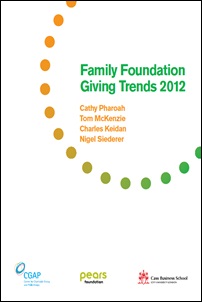Published titles
What we’ve delivered
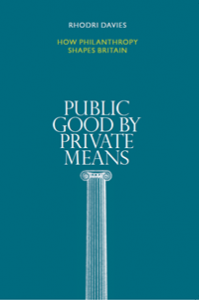 Public Good by Private Means: How Philanthropy Shapes Britain
Public Good by Private Means: How Philanthropy Shapes Britain
Rhodri Davies
Price $26.00/£18 plus P&P (£2.80 UK, £6.65 Europe, £7.00 rest of the world)
ISBN 978-1-907376-24-5
Public Good by Private Means tells the story of philanthropy through the ages. It examines the relationship between philanthropists, the state and society, and throws light on the successes – and occasional spectacular failures – of great philanthropists from the past. It shows what history can tell us about modern philanthropy, including some of the current criticisms it faces, and considers difficult issues such as the link between tax and giving and the motivations of the wealthy. Available from Amazon.
 Staying the Course: Reflections on 40 Years of Grantmaking at the Rockefeller Brothers Fund
Staying the Course: Reflections on 40 Years of Grantmaking at the Rockefeller Brothers Fund
William S. Moody With Priscilla Lewis, Editor
Price $25.00/£15.60 plus P&P (£2.80 UK, £6.65 Europe, £7.00 rest of the world)
ISBN 978-1-907376-21-4
How do you empower people to improve their lives and communities? How do you build trust across sectoral, ethnic, cultural, and other divides? How do you nurture a viable civil society? These are among the perennial questions Bill Moody addresses in Staying the Course.
This book is about helping local people in their communities around the world make lasting, positive change. Drawing on insights from a 40‑year grantmaker’s career at the Rockefeller Brothers Fund in New York City, Bill Moody shows how relatively modest contributions of money, along with time and energy, can have big impacts on the economic, cultural, environmental, governance, and other challenges that face transforming societies. Click here to download an order form. Also available from Amazon.
 Private Battles
Private Battles
Diana Leat ISBN 978-1-907376-20-7
This is the story of the work of the Rockefeller Foundation in Europe during and immediately after the Second World War. Sometimes doing things that governments could not do, or that public opinion would not support, the Rockefeller Foundation contributed to the saving and re-building of modern Europe.
At one level this is a war-time adventure story involving bombs, espionage, dramatic escapes, personal tragedies and privations. At another level, the story illustrates the fundamental, and enduring, dilemmas of foundations’ roles and practices, as well as highlighting the real complexity of foundations’ “independence”, and their dependence on stable government, reliable networks, knowledge and functioning infrastructure. Finally, the book is a story of personal, organisational and political battles, and the tenacity and bravery of the people who fought them. Available to read online
 Revealing Indian Philanthropy
Revealing Indian Philanthropy
Mathieu Cantegreil, Dwep Chanana, Ruth Kattumuri ISBN 978-1-907376-19-1
India is set to become one of the world’s leading producers of wealth. The country has a long tradition of giving and it should therefore come as no surprise if it also takes the lead in philanthropy. However, philanthropy in the country remains largely undocumented compared to other leading philanthropic nations.
From the role it played in supporting the establishment of modern India to the innovative work of recent years, philanthropy has played, and continues to play, a critical role in the development of the country. The current resurgence of Indian philanthropy shows us that there remains a culture of giving. This culture, replete with imagination and talent, should provide inspiration to philanthropists throughout the world.
This book sheds light on the great story of Indian philanthropists – a story that is often unknown, forgotten or misunderstood. In so doing, it offers an optimistic view of the state of philanthropy in the country and seeks to inform and inspire emerging Indian philanthropists to build ambitious visions of what they can achieve. Available to read online
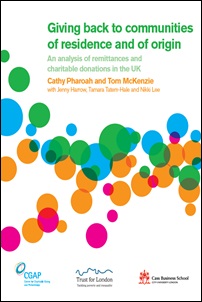 Giving back to communities of residence and of origin
Giving back to communities of residence and of origin
Cathy Pharoah, Tom McKenzie, Jenny Harrow, Tamara Tatem-Hale, Nikki Lee ISBN 978-1-907376-18-4
Giving back to communities of residence and of origin highlights the huge contribution made by the UK’s migrant and minority communities to the culture of giving in the UK, a country with a strong charitable sector.
In spite of the UK’s multicultural population, little is known about the true nature or scale of the support which its diverse communities give to those in need. Traditional giving surveys fail to capture their true levels of giving which include donations to charitable causes in the UK as well as amounts sent overseas to individuals, communities and countries of origin, through the ‘remittances’ that are now a recognised part of international development aid.The research in this report addresses this disturbing gap. Based on a new study of household spending data, and in-depth interviews with remitters, it shows for the first time that giving to charities in the UK and remitting money and gifts overseas are linked behaviours.
It finds a high level of generosity and community responsibility among migrant and minority households where those sending money overseas are also more likely to donate to UK charities. A significant level of personal sacrifice is often made by those sending money overseas, one quarter of whom are located in London where the cost of living is amongst the highest in the world. Over one tenth of households that remit are at risk of poverty.
The findings are timely in a period of economic stress in the UK, with renewed awareness of the need to give back to the community, and government support for policy and practice to promote it. As we look for new ways in which individuals can directly help to strengthen their communities, traditions of giving amongst the UK’s migrant and minority populations provide valuable models. The experiences of diaspora philanthropy deserve to be better shared, valued and celebrated. The report also argues that there should be more support to enable migrant and minority communities to give in ways that generate greatest impact, and benefit from the valuable incentives for charitable giving in the UK. Available to read online
Family Foundation Giving Trends 2012
Cathy Pharoah, Tom McKenzie, Charles Keidan, Nigel Siederer ISBN 978-1-907376-17-7
This is the fifth annual Family Foundation Giving Trends report, the leading source of information on major philanthropy in the UK. This is a special edition. Produced collaboratively by a foundation and academic team, it includes not only an update on the top UK family foundation donors, but also new insights into their decision-making and their outlook for the future in a difficult economic climate.
The report reveals the significant support for the arts, education, science and social welfare in the UK today made by our major family foundations such as Garfield Weston, Children’s Investment Fund, Esmée Fairbairn, Wolfson, Nuffield and many others. But foundations face increasingly hard spending choices in the current economic climate. How will they respond to gaps in welfare spending that emerge as public sector budgets reduce, or juggle priorities amidst competing demands for support? Will new opportunities for giving such as social investment play an increasing part in philanthropy? The report provides insights into how foundations themselves see the shape of future giving.
An additional table of smaller and newer family foundations is included in the report for the first time this year. These bear witness to the generosity of successful entrepreneurs of modern times, and include familiar names such as Roddick, Dyson, Cohen and Moores. It is hoped that such names and examples will inspire many others to give.
The report provides significant evidence of how the family foundation continues to flourish as a flexible, effective and sustainable way of contributing to our public wellbeing. However, future healthy growth in such philanthropy will depend on creating the right environment. The report explores how much family foundations prize independence and freedom to follow their own values and choices. It provides a wake‑up call to government, policymakers and others that they need to respect and protect the role of private action for public good.
Available to read online
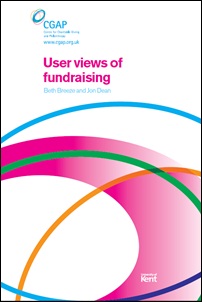 User views of fundraising
User views of fundraising
Beth Breeze and Jon Dean ISBN 978-1-907376-16-0
The use of visually striking images in fundraising materials can raise large sums of money for charities, yet has also led to accusations of exploitative ‘poverty porn’. This report explores the tension between discomfort at the use of images that could be seen as emotionally manipulative and the resulting success of fundraising appeals.
Based on focus groups with homeless young people, it is the first research to explore the opinions of those represented in charity campaigns.
Charitable beneficiaries are largely supportive of methods that maximize income, yet would prefer fundraising imagery that elicits empathy and ‘tells stories’ about how people find themselves in need of charitable assistance, rather than pictures that provoke pity and depict beneficiaries at their lowest ebb.
Available to read online
 Philanthropy and a better society
Philanthropy and a better society
ISBN 978-1-907376-15-3
Every aspiring reforming government needs a big idea, and for the Conservatives in 2010 it was the Big Society. Not everyone greeted this big idea with equal enthusiasm, but it is playing a part in the new debate under the Coalition about the right balance of state, private and voluntary sector in the future provision of welfare.
What role does philanthropy have in our society and how can it be enhanced? Does a better society depend on better philanthropy? Or do the limitations of philanthropy mean that, far from redressing inequalities, it often only reflects existing ones?
Such questions are explored in the 13 chapters of this report written by researchers in the ESRC Centre for Charitable Giving and Philanthropy (CGAP). The report highlights the implications of CGAP’s research findings for philanthropy in our society today, for the needs and ideals of the Big Society, and for future policy and practice.
Available to read online
 Family Foundation Giving Trends 2011
Family Foundation Giving Trends 2011
Cathy Pharoah, Charles Keidan, Jillian Gordon ISBN 978-1-907376-14-6
In a climate of reduced government spending and weak economic growth, the need to increase the contribution of philanthropy is ever more pressing. But UK giving has faltered over the last few decades: for many wealthy people philanthropy is still unknown territory. What is it? Where do you start? How can you give hard-earned wealth away effectively?
Family Foundation Giving Trends 2011 is the fourth report in a new series tracking trends in the annual value of family giving through foundations. This year’s edition focuses particularly on illustrating the hugely varied routes into philanthropy of today’s major donors. It is not a ‘how-to’ guide, but presents compelling examples of founders and their charitable foundations − small, large, new and established − in the hope that this will encourage others to find their own way.
Case studies include the Hunter Foundation, the Helen Hamlyn Trust, the Wood Family Trust, the A M Qattan Foundation, the Brian Kennedy Trust, the Emily Hughes-Hallett Fund, the Maurice Wohl Charitable Foundation and Pears Foundation.
The examples reveal the many different starting points for those with sufficient wealth to give some away. They show the challenges of replacing business targets with philanthropic goals, of bringing families and friends on board, and the joy of giving in an effective way. Family foundations are as individual as the donors who created them. The report calls on charities, professional advisers and policymakers to develop imaginative and supportive ways for potential donors to share experiences and learning.
Available to read online
 Raymond Georis: A quiet European gardener
Raymond Georis: A quiet European gardener
David Watkiss ISBN 978-1-907376-09-2
A detailed account of Raymond Georis’ life and multifaceted works is beyond the scope of this book. Its intention is more modest. It seeks to provide a portrait of a unique man and then distil some lessons from his life, personality and career as a philanthropic entrepreneur and visionary. It is part memoir, part biography. It is based largely on many pleasant and inspiring hours of conversations with Raymond and many of his friends, as well as on material from institutional archives and his personal papers.
Available to read online
A Minority View: Wha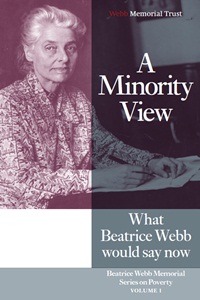 t Beatrice Webb would say now?
t Beatrice Webb would say now?
Barry Knight ISBN 978-1-907376-11-5
Beatrice Webb made a major contribution to social policy by showing that poverty is caused less by a failure of individual character and more by systems and structures over which an individual has little control. Her work laid the foundations of the welfare state.
However, after all these years, poverty remains a stain on our society, and looks set to get worse. The Webb Memorial Trust asked some of Britain’s best‑known experts to say what should be done to address it. A Minority View: What Beatrice Webb would say now presents their answers.
This book is the first of a series to be developed by the Webb Memorial Trust. The series will develop a narrative of what a society without poverty would look like, and how it could be achieved. Such an approach involves a combination of radical and practical thinking on work, income, taxation, social security, wealth, values and much more. We want the series to become a blueprint for change.
Available to read online
 The Art of Difference
The Art of Difference
Gottfried Wagner ISBN 978-1-907376-12-2
The Art of Difference is, in many senses, both a personal and a political book. It seeks to show how an individual can get very close to European matters emotionally, not least in terms of feeling some responsibility for the common good (which transcends national boundaries). It is also partly a record of the author’s personal journey within a world of people, projects and artistic practice, arriving at a deep concern for cultural policies that could underpin a truly transnational Europe.
The book is based on affection for this extraordinary and (so far) successful ‘project Europe’: a political project for which contemporary and future narratives need to be developed, especially given the deep crisis of capitalism. As the author says: ‘In that search, there is a role for culture, not for culturalization of difference, though; and there is a place to be occupied by public cultural policies – European and global.’
Though firmly believing in ‘word‑culture’ and discourse, the author underlines the power of imaginaires to link critical intelligence with some kind of shared democratic utopia. The author’s own photographs included here form part of his political documentary.
Available to purchase from Amazon
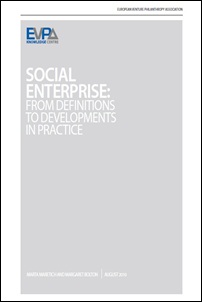 Social Enterprise: From definitions to developments in practice
Social Enterprise: From definitions to developments in practice
Marta Maretich, Margaret Bolton ISBN 978-1-907376-06-1
Venture philanthropy has come a long way since the European Venture Philanthropy Association (EVPA) was set up in 2004. The distinction between the nonprofit and the for-profit sectors has become blurred with the emergence of social entrepreneurship and the increased demand for transparency and performance measurement to assess the efficiency of nonprofit organisations. Meanwhile, foundations have considered how to change some of their practices in order to better assist the social sector and how to align their investments with their social mission. Venture philanthropy is positioned at the intersection of the for-profit and nonprofit sectors. As such, venture philanthropy includes high engagement and a range of financing mechanisms tailored to the needs of the social purpose organisation, be it a nonprofit organisation or a social enterprise. Some venture philanthropists started off providing grants to nonprofit organisations , albeit in an engaged manner. Others supported social enterprises through tailored financing. Many have realized that they share the overall aim of building stronger organisations that can better achieve social impact.
However, although providing grants to nonprofit organisations and investing in social enterprise (social investing) have many things in common, there are also differences between the two approaches. The EVPA has acknowledged the potential of “social investing” and has decided to undertake several actions to enhance its knowledge thereof. The aim is to assist our members in developing best practices, and attracting resources to the area. This paper is the first in a series of research reports with a focus on social enterprise investing. The report was commissioned to two consultants with knowledge of the social enterprise space. The objective of this first paper was largely exploratory: to determine how academics and practitioners define social enterprise and how EVPA members are evolving methods for supporting social enterprise. The paper offers a broad definition of social enterprise and some sub-types that are intended to provide practitioners with multiple pathways to engage in social enterprise. Since the development of this report, the EVPA has decided to set up a task force on social investment. The next report on investing in social enterprise will build on the work of this group of experts. We hope that this report will encourage the exchange of ideas and lead to best practice for investing in social enterprise.
Available to read online
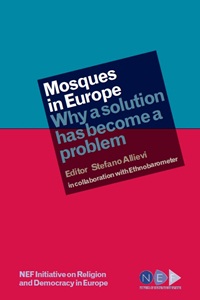 Mosques in Europe: Why a solution has become a problem
Mosques in Europe: Why a solution has become a problem
Stefano Allievi ISBN 978-1-907376-07-8
The presence of ever-growing Muslim communities in European countries should lead, as an obvious consequence, and in the same way as with other religious communities, to an even greater number of Islamic places of worship, all following on historical and sociological trends, and the founding juridical principles of European states, which were inspired by the idea of religious freedom as a fundamental right.
In reality, as we know from the news every day, things are not so: Muslim prayer rooms are spreading rapidly, but conflicts over the construction of mosques in Europe are also multiplying in their turn, at the local and national level. The Swiss referendum against minarets in November 2009 was a striking demonstration of this.
Mosques in Europe: Why a solution has become a problem, based on original empirical research carried out in the principal European countries, not only gives recent data on the situation of Islamic presence in Europe, but also attempts to give a detailed response to the questions that this presence poses, especially regarding places of worship. The book tries to understand why what should have been an obvious solution to a problem has become a problem itself, and what are the possible ways out.
An indispensable text for understanding what really happens when we speak of mosques, but also a useful interpretative tool for suggesting how to emerge from the logic of conflict, guaranteeing not only the principles of religious freedom but also the needs for safety and control, and above all understanding what the real stakes are, for the present and for the future, concerning the Islamic presence in Europe.
Available to read online
 Family Foundation Giving Trends 2010
Family Foundation Giving Trends 2010
Cathy Pharoah, Charles Keidan ISBN 978-1-907376-08-5
Just as we are experiencing severe reductions in public expenditure, and the wealthy are being urged to give more back to society, this report provides timely data on the charitable giving and activities of major family foundations. It attempts to draw the ‘big picture’ of family foundation giving in the 21st century.
Family Foundation Giving Trends 2010 is a collaboration between academics and practioners in philanthropy, and the third report in a new annual series. It updates figures for the giving of the UK’s family foundations in 2008/09, providing a table of the largest 100, analysing the impact of recent economic turbulence and comparing trends with those in the US.
With many new family foundations established by the successful entrepreneurs of an era of expanding global markets and capital flows, including, for example, the Waterloo Trust, set up by the founders of Admiral Insurance, and the Volant Trust, set up by J K Rowling, the research shows that family foundation giving has been remarkably resilient in recent difficult times.
The report provides many examples of foundations, founders and funding awards, revealing significant national investment in education, science, culture and the environment. It shows foundation leadership and innovation in approaches to some of society’s most intractable problems, and highlights how foundations mobilize resources by working in partnership with civil society, government and business.
Giving, however, is often driven by personal vision and thinly stretched over a breath-takingly wide range of need. In showing how much has been attempted with limited resources, the report aims to encourage others to give more, and give effectively.
Available to read online
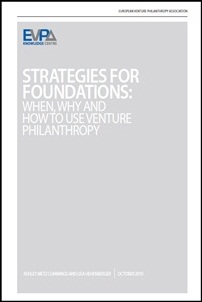 Strategies for Foundations: When, why and how to use venture philanthropy
Strategies for Foundations: When, why and how to use venture philanthropy
Ashley Metz Cummings, EVPA, Lisa Hehenberger ISBN 978-1-907376-10-8
Venture philanthropy (VP), including grant funding and social investment, is a tool in the global toolbox for foundations; it is not intended or expected to revolutionise philanthropy, but can serve as a worthy model for some foundations. Venture philanthropy strategies need not replace existing approaches, but rather are additional elements to add to a foundation’s repertoire. Many foundations will likely be surprised by the amount of venture philanthropy ‘tools’ they are already storing in their toolboxes.
As the paper discusses, venture philanthropy can introduce or reaffirm important practices. The manner in which venture philanthropy considers an entire organisation with a long-term view is particularly impressive. This more holistic approach effectively builds stronger, more sustainable organisations. Adding in evaluation and performance measurement is particularly important for ensuring optimal planning, process and results. In this way, venture philanthropy does not have to be used in entirety, but as a set of examples to be drawn from and innovated upon when need arises.
Whether or not venture philanthropy strategies are considered new or old is beside the point. It is important to realise that these strategies offer up good practice. Foundations stand to benefit from being open, versatile and ready to adopt diverse elements into their ways of working in the hopes of acting more effectively in a nuanced sector, contributing to achieving their wider mission. Foundations should, therefore, seriously consider venture philanthropy strategies and incorporate them into their work. The case studies in this paper describe how some different yet very successful foundations have integrated the VP approach in their strategy. We invite all decision makers to engage in such strategic thinking.
Available to read online
 How Donors Choose Charities
How Donors Choose Charities
Beth Breeze ISBN 978-1-907376-05-4
There are tens of thousands of charities in the UK, and even the most generous donors can support only a tiny fraction of these good causes. This paper examines how donors go about choosing which organisations to give their money to.
Based on interviews with 60 committed donors, it explores how people define charity, what they think about charitable beneficiaries, and the rationale behind their giving decisions.
Despite widespread assumptions that need is the primary driver of charitable donations, this study finds that giving decisions are also based on other factors, notably donors’ tastes, personal experiences, perceptions of charities’ competence and a desire for personal impact.
Available to read online
 Laying the Foundations: 20 years of the EFC
Laying the Foundations: 20 years of the EFC
ISBN 978-1-907376-03-0
A current snapshot of the EFC shows a thriving membership association, with 230+ member foundations from more than 40 different countries around the globe. The EFC’s 20th anniversary celebrations, held on 9–10 November 2009 in Berlin, not only showcased the vital work carried out by the Centre over its first two decades, but also more generally marked the maturation of a flourishing European foundation community.
Yet to reach this point, a cast of characters had to build the EFC from the ground up, relying on their own entrepreneurship, perseverance and, once in a while, a bit of good luck. Laying the Foundations recounts the full, previously undocumented, history of the EFC, starting from the Centre’s humble beginnings when the original seven founding members came together on 9 November 1989, up until the present.
A story told from the perspective of the members, the book presents a side to the EFC that one may not have been aware of otherwise. What was the role that Spanish foundations played in the establishment of the Centre that they still speak about so proudly today? Was it really just a historical coincidence that the EFC was founded on the same day the Berlin Wall fell? What was the ‘Great Vasa Project’, and why would certain members and EFC Secretariat staff prefer to forget it? Compiled following an extensive series of interviews, this book provides answers to these questions, among many others, and pays homage to those who have left their unique, indelible marks on the European foundation sector.
Available to read online
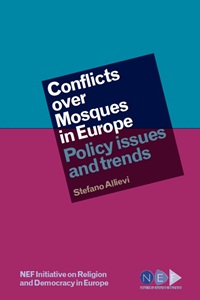 Conflicts on Mosques in Europe: Policy issues and trends
Conflicts on Mosques in Europe: Policy issues and trends
Stefano Allievi ISBN 978-0-9558804-7-6
The presence of Islam in Europe’s public space provokes debate and tension for a host of reasons – historical, cultural, religious, political and social. The most significant and widespread of these debates centres around mosques as they have very powerful symbolic implications. These disputes are not limited to the establishment of places of worship; they also relate to the question of their visibility in European cities, for instance through the building of minarets. Related questions concern the broadcasting of the adhan, the call to prayer, and Muslim cemeteries.
Based on new research in several European countries and on detailed national overviews, this report analyses a wide range of conflicts over mosques and proposes an interpretation of such conflicts in a wider frame, in order to understand the reasons why they emerge, how they develop, the role of the different actors involved, and the lessons that can be learned from them in terms of social dynamics and governance.
Available to read online
 Philanthropy in the 21st century
Philanthropy in the 21st century
Lindsay Driscoll, Peter Grant ISBN 978-1-907376-01-6
Philanthropy in the 21st Century is the result of a research study commissioned by the Honorary Treasurers Forum. The authors questioned a wide range of practitioners, academics and thinkers to explore ideas that might increase the effectiveness of philanthropic giving.
The onset of the worst economic crisis since the 1930s acted as a backdrop to the study, which posits a number of wide-ranging, sometimes controversial ideas.
Proposals for government include: establishing a range of umbrella charities with donor advised funds set up with government seed funding; enhanced tax incentives for donations to these donor advised funds; the possible introduction of a minimum percentage payout for foundations, and revisiting the rules governing remainder trusts.
Proposals for foundations are that they: review their current commitments and policies to ensure their funding models are impact based and take into account the life cycle of recipients; review their governance and grantmaking procedures to ensure that they focus on strategy and that risk is appropriately managed; and report on the added value of their grant-giving in the context of public benefit.
Available to read online
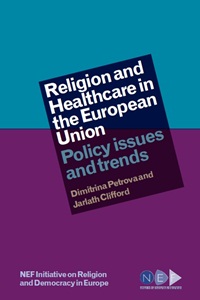 Religion and Healthcare in the European Union: Policy issues and trends
Religion and Healthcare in the European Union: Policy issues and trends
Dimitrina Petrova, Jarlath Clifford ISBN 978-0-9558804-6-9
The impact of religious doctrine on the law, policy and practice of healthcare is becoming increasingly significant for a whole range of issues – from euthanasia to fertility treatment; from belief-based exemption from performing abortion for doctors to the medication and dietary needs of religious patients; from organ donation to contraception; from circumcision to suicide. The relationship between religion and healthcare has a long history of evoking tension and debate in Europe. While developments in medical technologies and techniques question the religious beliefs of policy-makers, practitioners and patients across the European Union, research into the legal and policy responses by EU member states on such issues remains underdeveloped.
The challenge of health policy, which is common across the European Union, is to balance fundamental human rights such as the right to equality, the right to health and the right to freedom of religion while adhering to secular principles.
This report aims to map out the major issues at stake and to initiate a broader discussion on how the religious needs of the community, religious doctrine and religious practices across the European Union affect public health policy.
Available to read online
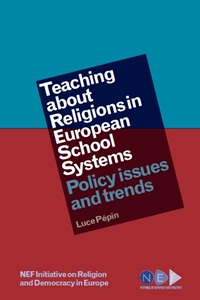 Teaching about Religions in European School Systems: Policy issues and trends
Teaching about Religions in European School Systems: Policy issues and trends
Luce Pepin ISBN 978-0-9558804-8-3
Why and how should public education teach about religions? The issue has become increasingly topical. Young people lack knowledge about the growing diversity of religions in European societies, which are becoming ever more multicultural and secular. This ignorance and a growing lack of religious and cultural references cut them off from their own roots and lay the foundations for intolerance and prejudice.
Teaching about religions and other convictions could play an important role in reversing this trend. While confessional education remains the most widespread approach, non-confessional and pluri-religious teaching, as well as teaching about ‘religious facts’, seems to be gaining ground, in line with recommendations adopted at European level.
Looking in particular at the situation in seven EU member states, this report identifies trends, key issues and challenges facing EU education systems if teaching about religions is to contribute to intercultural and citizenship education and puts forward some recommendations to help bring this about.
Available to read online
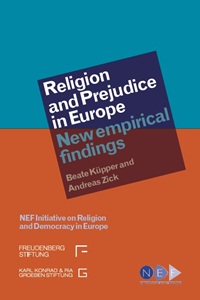 Religion and Prejudice in Europe: New Empirical Findings
Religion and Prejudice in Europe: New Empirical Findings
Beate Kupper, Andreas Zick ISBN 978-1-907376-02-3
World religions usually call for peace and brotherhood, and religious people around the globe support others in need and contribute generously to charity. However, in the name of religion we also see hate, violence and inter-group conflicts. Religion is sometimes used by religious people to legitimize the devaluation of others because of their group membership, beliefs, ethnicity, gender or sexual orientation. Knowing more about the relationship between individual religiousness and tolerance can help us understand the role of religious actors in social cohesion, individual behaviour, and the structuring of institutions.
Religion and Prejudice in Europe presents new empirical findings on the relationship between individual religiousness and prejudice towards a variety of target groups that have been identified by the European Union as needing protection from discrimination. The findings were realized within the study ‘Group-focused Enmity in Europe’ and based on representative surveys conducted in eight European countries, which were selected for their different religious make-up. Findings reveal that religious people have a greater tendency to be prejudiced towards various groups (in particular women and homosexuals) than non-religious people.
Available to read online
 Understanding European research foundations: Findings from the FOREMAP project
Understanding European research foundations: Findings from the FOREMAP project
ISBN 978-1-907376-00-9
What do you know about foundations’ contribution to research in your country?
Research is ever-present in all aspects of our lives, from driving innovation and economic development to contributing to the development of therapies and informing policymaking. In every European country foundations are supporting research, yet how much do we know and understand of their contribution, beyond the anecdotal? In an era in which research is of increasing strategic importance, it is crucial that we seek answers to this question in order to gain a better understanding of foundations’ added value, which lies beyond the purely monetary.
Understanding European Research Foundations details the work of the FOREMAP project. The project sought to develop a mapping methodology and tools to document foundations’ support for research, and to enable the collection of comparable data across countries to give a Europe-wide picture of their activity. The report also provides a glimpse of how foundations are supporting research in Germany, Portugal, Slovakia and Sweden, where the FOREMAP mapping methodology was tested. Foundations, associations of foundations, policymakers and scientists would all benefit from a greater understanding of research-funding foundations. What role can these stakeholders play in this respect, and how can they build on the work of FOREMAP? Readers should consider this report as the first step in a process of obtaining a global picture of how and why foundations support research in Europe.
Available to read online
 Small Money, Big Impact Foundations for Peace report
Small Money, Big Impact Foundations for Peace report
Foundations for Peace ISBN 978-0-9558804-5-2
Small Money, Big Impact is a report drawn from the combined experiences of nine independent charitable trusts and foundations that are members of the Foundations for Peace Network. What is both unique and compelling about these organizations is that they are all indigenous to, and working in, societies that have been marked by deep communal divisions and violent conflict. They share a commitment to social justice and peacebuilding in often difficult and complex circumstances.
Drawing on nine detailed case studies from eight countries in Asia, Latin America and Europe, this illustrated report discusses the relationship between social justice and peacebuilding while reflecting on the added value of using indigenous foundations to deliver local programmes in areas of conflict and division. A common theme is how small amounts of money can leverage major impact in terms of building solidarity and partnerships for social change.
Available to read online
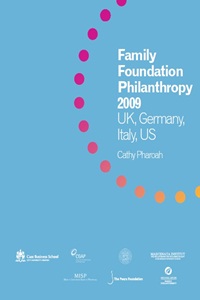 Family Foundations Philanthropy 2009: UK, Germany, Italy, US
Family Foundations Philanthropy 2009: UK, Germany, Italy, US
Cathy Pharoah ISBN 978-0-9558804-4-5
The Bill and Melinda Gates Foundation currently provides the most concerted challenge to government approaches to tackling problems of global health. At the same time, the foundation set up by business billionaire Hans‑Werner Hector made, in 2008, the largest single donation ever to a German state university, causing national controversy over the status of so‑called ‘elite universities’. In the light of these and other strategic initiatives, the influential role of family foundation philanthropy in social policy and practice has never been more topical.
Family Foundation Philanthropy 2009 updates and compares trends in the charitable spending of major family foundations in the UK and US. It also presents new data on family foundations in two contrasting continental European countries, Germany and Italy. The historical, legal and political contexts in which such foundations operate in these countries are shown to be significantly different, yet in spite of these differences philanthropy of this kind has constantly found ways to re‑emerge and reconfigure itself.
The research presented here demonstrates the strength of family foundation philanthropy and the extent to which it has become a vehicle for successful entrepreneurs and other donors not only to support, but often to strategically influence, the scientific, cultural, social and economic progress of their time. The study also raises questions about the common themes and overarching motivations which give family foundation philanthropy a continuing role under sometimes difficult conditions and in different times, contexts and places.
Available to read online
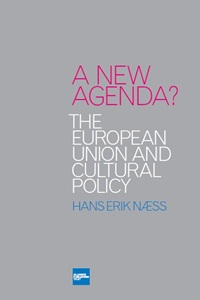 A New Agenda? – The European Union and cultural policy
A New Agenda? – The European Union and cultural policy
Hans Erik Naess ISBN 978-0-9558804-3-8
Throughout the last couple of decades, from the fall of the Berlin Wall to globalization issues of today, various aspects of culture seem to affect the lives of European citizens more and more. As a reply the European Union (EU) in 2007 endorsed ‘A European agenda for culture in a globalising world’, evidently their ‘first-ever strategy for culture’.
To anyone familiar with the history of the EU, this was groundbreaking news. Culture had for the first time been elevated into the premier league of EU politics. In this book, which ranges from cosmopolitan philosophy to Playstation games, Norwegian sociologist Hans Erik Næss investigates the case further: what is the content of this strategy, what is new about it, and how will it affect European and national cultures?
This book allows the reader to explore these questions. Written in an easily accessible style, putting emphasis on exploration rather than tutoring, it provides students, philanthropists, culture journalists, artists, NGO staff, politicians and the like with a creative introduction to the interaction between EU policies and European culture.
Available to purchase on Amazon
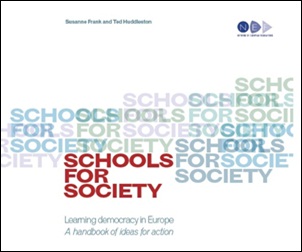 Schools for Society: Learning Democracy in Europe – A Handbook of Ideas for Action
Schools for Society: Learning Democracy in Europe – A Handbook of Ideas for Action
Susanne Frank, Ted Huddleston ISBN 978-0-9558804-2-1
As we launch this handbook, democracy is experiencing unprecedented challenges throughout Europe, as a result of the impact of the credit crunch and economic recession. Globalization, unemployment, migration, social justice and human rights are high on everyone’s agenda, and at the same time citizens increasingly question the effectiveness of present political parties to meet these challenges. Education for citizenship assumes even greater significance and schools have to adapt their mission, governance and working methods to play their crucial part in delivering opportunities for young people to prepare to live and work in this rapidly changing world. What lessons and insights can be drawn from European experience?
Schools for Society maps out a range of ways in which schools can help to nurture the civic skills and values of citizens in Europe, both young and old, through closer cooperation and partnership with civil society. It shows how civil society organizations can act as catalysts for new thinking and practices in democratic education, and identifies a number of strategies and approaches by which this can be achieved – with illustrative case studies taken from 11 different countries, from England and France to Poland and Turkey. In doing so, this handbook goes beyond conventional understandings of democratic schooling, often restricted to pupil participation, to
open up a new agenda for democratic learning and action in and through schools in Europe. While written primarily with foundations and civil society organizations in mind, it contains valuable insights for anyone interested in democratic education.
Available to read online
Religion and D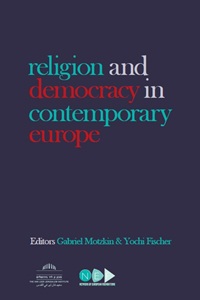 emocracy in Contemporary Europe
emocracy in Contemporary Europe
Editors Gabriel Motzkin & Yochi Fischer ISBN 978-0-9558804-1-4
The resurgence of religion in contemporary European culture is challenging older notions of the ‘secular’ and ‘secular democratic’ state. This debate goes to the roots of European identities, calling into question conventionally accepted political ideas and raising many key issues. To what extent can or should states impose limits on religions? How can some measure of European collective identity be achieved? What is the function of education with respect to religion?
The frequency of tensions and conflicts associated with religion has increased sharply in Europe, yet many research projects and policy-oriented initiatives have failed to assess the place of religion in the wider context of other social, cultural and political processes. Religion and Democracy in Contemporary Europe fills this scholarly lacuna.
The papers in this volume were first presented at an international conference at the Van Leer Jerusalem Institute in September 2007. The conference, part of the Religion and Democracy in Europe Initiative of the Network of European Foundations, brought together leading experts on the study of religion, democracy and secularism. Their various contributions, collected here, offer innovative ideas and solutions to the dilemmas that will confront Europe over the coming decades.
Available to read online
 Philanthropy in Europe
Philanthropy in Europe
Norine McDonald, Luc Tayart De Borms ISBN 978-0-9558804-0-7
Numerous books have been published on American philanthropy – its origins, its heroes, its achievements and its shortcomings. But philanthropy in Europe has been largely neglected. This book will start to fill this gap.
The book examines the tradition, history and diverse roles of philanthropy in Europe through profiles and essays. The book contains 13 profiles of philanthropic endeavours in Europe. Some feature individuals, such as Calouste Gulbenkian, Bernard van Leer, Stephan Schmidheiny and Henry Wellcome. Others portray living donors of today or describe foundations not established by individuals such as Compagnia di San Paolo and the Fondation de France.
These portraits are followed by six essays written by practitioners and experts focusing on the different roles foundations play in our societies and insights on the diverse origins of philanthropy in Europe. Available to read online
See our current suite of publishing services

